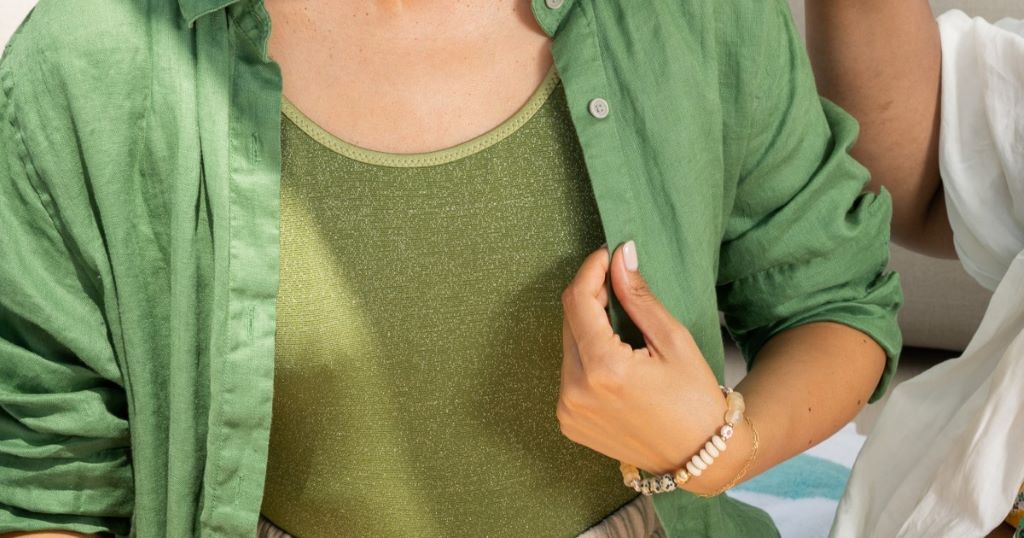Traveling to hot destinations can be challenging when you’re prone to sweating. The right shirt material makes all the difference between a comfortable journey and a sticky, uncomfortable experience. Smart travelers know that choosing appropriate clothing is essential for enjoying their adventures. Dress 24h offers extensive guidance on selecting the perfect fabrics for various climates and situations.
When planning your next tropical getaway or summer vacation, understanding fabric properties becomes crucial. Different materials respond differently to heat, humidity, and perspiration. Therefore, making informed decisions about your travel wardrobe can significantly impact your comfort level throughout your trip.
Understanding Fabric Performance in Hot Weather
Choosing the right fabric involves understanding what shirt material is best for hot weather. Several factors determine how well a material performs in challenging conditions. Breathability allows air circulation through the fabric fibers. Additionally, moisture-wicking properties help move sweat away from your skin to the fabric’s surface where it can evaporate quickly.
Natural fibers like cotton and linen have been popular choices for centuries. However, modern synthetic materials often outperform traditional options in specific situations. Furthermore, fabric weight and weave structure significantly affect how comfortable you’ll feel in hot climates.
Top Shirt Materials for Hot Weather Travel
Merino Wool
Surprisingly, merino wool excels in hot weather despite common misconceptions. This natural fiber offers exceptional temperature regulation and odor resistance. Moreover, merino wool naturally wicks moisture while remaining soft against the skin. The fine fibers create tiny air pockets that provide insulation in cold weather and cooling in hot conditions.
Merino wool shirts dry relatively quickly compared to cotton alternatives. Additionally, they resist wrinkles and maintain their shape after multiple washes. However, they typically come with a higher price point than synthetic options.
Synthetic Moisture-Wicking Fabrics
Modern synthetic materials like polyester blends and nylon combinations offer superior moisture management. These engineered fabrics move sweat away from your body more efficiently than most natural fibers. Furthermore, they dry exceptionally fast, making them ideal for active travelers or those visiting humid destinations.
Synthetic fabrics often incorporate antimicrobial treatments to prevent odor buildup. Therefore, you can wear them multiple times between washes during extended travel periods. However, some people find synthetic materials less comfortable against their skin compared to natural fibers.
Linen
Linen remains a classic choice for hot weather travel due to its loose weave and natural breathability. The fabric’s structure allows maximum air circulation, keeping you cooler in extreme heat. Additionally, linen becomes softer and more comfortable with each wash and wear.
The main drawback of linen is its tendency to wrinkle easily. However, this characteristic has become part of its casual, relaxed aesthetic that many travelers appreciate. Moreover, linen’s natural moisture absorption helps keep you feeling fresh throughout the day.
Bamboo Fabric
Bamboo-derived fabrics offer excellent moisture-wicking properties with a silky smooth feel. These materials naturally resist bacteria and odors while providing UV protection. Furthermore, bamboo fabric production is often more environmentally sustainable than traditional cotton farming.
The softness of bamboo fabric makes it comfortable for sensitive skin. Additionally, it maintains its shape well and resists fading after multiple washes. However, the manufacturing process varies significantly between brands, affecting quality and performance.
Cotton Considerations for Travelers
Regular cotton presents mixed results for sweaty travelers. While comfortable initially, cotton absorbs moisture and retains it against your skin. Therefore, you may feel damp and uncomfortable in humid conditions. However, certain cotton treatments and blends can improve performance significantly.
Pima cotton and Egyptian cotton varieties offer superior quality and breathability compared to standard cotton. Additionally, cotton-synthetic blends combine natural comfort with improved moisture management. Furthermore, treated cotton fabrics can provide enhanced performance characteristics.
Fabric Treatments and Technologies
Modern textile technology has revolutionized how fabrics perform in challenging conditions. Moisture-wicking treatments applied to natural fibers can dramatically improve their performance. Additionally, antimicrobial finishes help prevent odor-causing bacteria from multiplying in sweaty conditions.
UV protection treatments add another layer of functionality for outdoor travelers. Moreover, wrinkle-resistant finishes reduce the need for ironing during travel. Therefore, these enhanced fabrics often justify their higher cost through improved functionality and convenience.
Choosing the Right Fit and Style
Beyond material selection, proper fit affects comfort significantly in hot weather. Loose-fitting shirts allow better air circulation around your body. However, extremely baggy clothing can actually trap heat and reduce cooling efficiency.
Look for shirts with ventilation features like mesh panels or strategic perforations. Additionally, consider shirts with longer tails that can be untucked for better airflow. Furthermore, light colors reflect heat better than dark colors, keeping you cooler throughout the day.
According to Travel + Leisure, proper clothing selection can make or break a travel experience in hot climates. The publication emphasizes choosing fabrics that prioritize comfort and functionality over fashion alone.
Care and Maintenance While Traveling
Proper care extends the life and performance of your travel shirts. Rinse shirts in cool water immediately after sweating heavily to prevent odor buildup. Additionally, pack mesh laundry bags to protect delicate fabrics during hotel washing machine cycles.
Air drying preserves fabric integrity better than high-heat dryer settings. Moreover, packing wrinkle-resistant fabrics reduces the need for ironing facilities. Therefore, choose materials that maintain their appearance with minimal care requirements.
Budget Considerations and Value
High-performance fabrics often command premium prices, but they provide excellent value for frequent travelers. Quality moisture-wicking shirts typically last longer than cheaper alternatives. Additionally, their superior performance can enhance your travel experience significantly.
Consider cost per wear when evaluating expensive technical fabrics. Furthermore, versatile pieces that work in multiple climates provide better value than specialized single-use items. However, budget-conscious travelers can find acceptable performance in mid-range synthetic blends.
Conclusion
Selecting the best shirt material for sweaty travelers involves balancing comfort, performance, and practicality. Merino wool offers natural odor resistance and temperature regulation. Synthetic moisture-wicking fabrics provide superior sweat management and quick drying. Linen delivers maximum breathability for extremely hot conditions. Bamboo fabrics combine comfort with sustainability.
Consider your specific travel needs, climate destinations, and personal preferences when making fabric choices. Additionally, proper fit and care maintenance significantly impact performance regardless of material selection. Therefore, invest in quality pieces that will serve you well across multiple adventures.
Frequently Asked Questions
Q: What is the best shirt material for humid tropical climates? A: Synthetic moisture-wicking fabrics perform best in humid conditions because they move sweat away from your skin and dry quickly. Merino wool is also excellent for humidity due to its natural moisture management properties.
Q: Can cotton shirts work for hot weather travel? A: Regular cotton can become uncomfortable when wet with sweat, but high-quality cotton blends with synthetic fibers offer better performance. Treated cotton with moisture-wicking properties can also work well for less active travel.
Q: How many travel shirts should I pack for a hot weather trip? A: Pack 2-3 high-performance shirts for trips up to a week. Quality moisture-wicking materials can be worn multiple times between washes, reducing luggage weight and space requirements.
Q: Are expensive technical fabrics worth the investment for casual travelers? A: High-performance fabrics provide significant comfort benefits in hot, humid conditions. For occasional travelers, mid-range synthetic blends offer good performance at lower cost. However, frequent travelers benefit from investing in premium materials.
Q: What shirt features should I look for besides fabric type? A: Look for loose-fitting cuts, ventilation panels, UV protection, and antimicrobial treatments. Additionally, consider wrinkle-resistance and quick-dry properties for travel convenience.
Read More:
How to Color Coordinate Men’s Clothing





